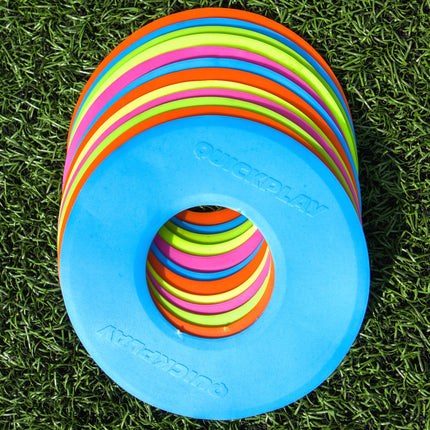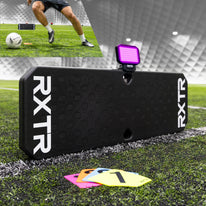
As an athlete or coach, you should always be looking for ways to improve your performance or the performance of your athletes. One of the most important performance characteristics you should be seeking to improve is speed. A common misconception is that you can’t train speed. You are either fast or you’re not.
I am here to tell you, that is not the case—You can train Speed! You can get faster!
Hopefully by the end of this article you will know one of the techniques that successful coaches and athletes use to increase their capacity for speed.
Resisted Speed Training is one of the best methods for training speed. This type of training focuses on improving the quality and speed of movement by using resistance in conjunction with sport or position specific sprints and drills.
The ability to achieve a high maximum sprinting velocity is crucial for most sports, in particular soccer, football, rugby, baseball, basketball, tennis and lacrosse.
Resisted Speed Training
To this day most athletic training programs use free weights and the Olympic lifts (Clean, Jerk, Snatch) for their high-intensity speed-strength training exercises. These “power” lifts combine strength and speed. They are effective because they improve muscle strength and the capacity to move heavy loads quickly. This translates to an increase in an athlete’s potential to be more powerful and move faster. Think about a vehicle with a large motor, it can produce more horsepower than a vehicle with a smaller motor.
However, many coaches are moving towards resisted speed training because most of the power training that is done in a gym has a vertical force emphasis (up and down). An athlete who needs to run fast needs to train these power movements with a predominantly horizontal emphasis. (side to side) Running fast is about pushing the ground down and back/away to produce horizontal force-velocity, and not simply down.
One of the other benefits of resisted speed training, rather than training for speed in the gym is that you are able to focus on the different phases of sprinting. The acceleration phase is everything that happens before you reach maximal velocity. Maximal velocity is also referred to as absolute speed or top-end speed.
Training Specificity

Research shows that resisted speed training should mimic the type of sport movement, but with added resistance. There are various ways to create resistance. The resistance can come from an elastic band, towing or pushing a weighted sled, a parachute, wearing a weighted vest or uphill sprinting. But to achieve the best results from specificity, your movement patterns should remain similar to those done while unloaded or unresisted.
Although high-intensity strength training programs (power, plyometrics) have proved to be effective in improving performance characteristics such a speed, according to the concept of training specificity, for best results the exercises must attempt to closely mimic the demands of the respective unloaded activity.
One study that examined the effects of resisted speed training versus traditional power training showed that there were larger improvements in sprint performance, and running kinematics (higher sprint velocity, stride length, shorter ground contact time) with resisted speed training. This is as a result of training horizontal force-velocity and not vertical force-velocity.
How To Do IT
Resisted speed training involves working against a resistive force--such as a sled, parachute, or elastic band while running drills and sprints. The added resistance forces the athlete to work harder to move faster, which helps improve their overall speed, technique and power profile.
Studies have shown that some of the benefits of towing a sled can benefit the different phases of the sprint. Training the acceleration phase should be done with a sled weighing more than 20% of your body weight, but not heavy enough to disrupt proper form and technique. I recommend using a harness, rather than a belt to reinforce torso-angle and midline control.
The benefits to the acceleration phase are: increased ground contact force, leg strength and drive, torso angle control, and low back-leg swing.
Training the maximal velocity phase should be done with a sled weighing less than 20% of your body weight, so as not to disrupt proper form and technique.
The benefits to the top-end speed phase are: decreased ground contact time, upright torso, cyclical leg movement.
Let me reiterate--This type of training stimulus must be done without inducing detrimental changes in sprint technique.
Although the acceleration phase is particularly relevant in sports which involve short bursts of speed like tennis, acceleration performance and maximum sprint velocity are separate and specific qualities. They should be trained individually and ideally on separate days.
You can combine the resistance training with our Utility Harness For Weighted Sleds constructed with the very best materials and reinforced stitching in areas where most harnesses in the market tend to fail.

Benefits
Resisted speed training not only leads to improved muscle strength in the lower body, but also reinforces coordination, agility and balance. Your torso, shoulders, and hips all must maintain a coordinated balance between stability and mobility.
One study showed that in addition to physical improvements, resisted speed training also has mental health benefits, since it requires focus and concentration in order to execute each exercise properly. By pushing yourself during each drill or sprint, you are challenging yourself mentally, as well as physically while also learning more about your body’s capacity for performance control. It is no surprise that many athletes find this type of training, incredibly helpful in their quest for improved performance. That said, it is important to note that each rep of resisted speed training happens in short bouts with correct technique and adequate rest in between.
Several studies that have examined the effects of resisted speed training have all revealed significant improvements in joint strength, rate of force development, balance, and midline posture and control after only four weeks of training.
To maximize the benefits of resisted speed training, the specificity training principle must be followed. Research on resisted speed training programs adhering to specificity of exercise have demonstrated great adaptation to in-game performance. In accordance with the principle of training specificity, resisted speed training protocols have become popular within sprint training regimens. The correlation to increased MPH and decreased sprint times is evident. The success of these regimens has validated inclined surfaces, weighted vests, parachutes, sleds and elastic bands, as adequate means to increase load resistance.
One study showed after six weeks of resisted speed training in the form of pulling a sled with a harness, athletes had improved their speed performance 30% more than the passive control group that did the same training regimen without resistance.
Resisted speed training is an effective way for athletes to develop greater levels of power and explosiveness on the field or court. It will help sprinters run faster and sport athletes play their positions stronger and quicker. Whether you use a harness and sled, belt and bungee, weighted vest, or run uphill, resisted speed training is something you should definitely include into your training program if you want to get faster or train others to get faster.

Michael Cummings
www.coach-cummings.com
Michael Cummings is a strength and conditioning coach in San Diego, CA. For more than 20 years he has coached Olympic and professional athletes to youth athletes. He is also a certified Rehabilitation Specialist and Brain Trainer. He is passionate about upgrading the performance of all athletes.







